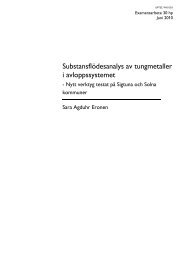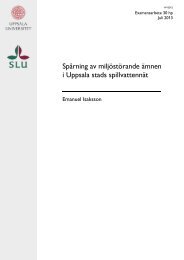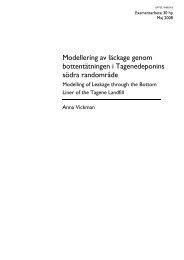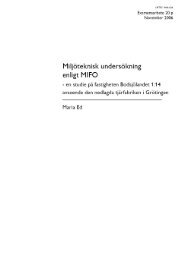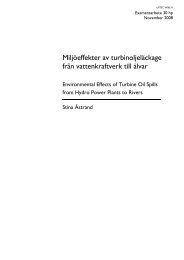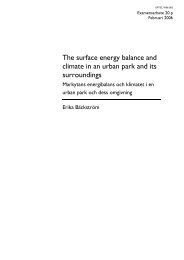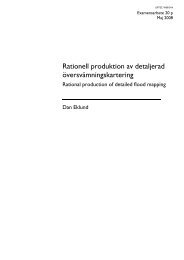Nutrient Transport Modelling in the Daugava River Basin - DiVA Portal
Nutrient Transport Modelling in the Daugava River Basin - DiVA Portal
Nutrient Transport Modelling in the Daugava River Basin - DiVA Portal
You also want an ePaper? Increase the reach of your titles
YUMPU automatically turns print PDFs into web optimized ePapers that Google loves.
Groundwater discharge to <strong>the</strong> river channel and percolation from groundwater zone 1 togroundwater zone 2 is calculated from recession coefficients, so that for each dayG1t= r1⋅S1t(4)G2t= r2⋅ S2t(5)G = gr ⋅ S1(6)ttwhereG1 t = flow from groundwater box 1 to <strong>the</strong> stream channel [cm/day]G2 t =flow from groundwater box 2 to <strong>the</strong> stream channel [cm/day]r1 = recession coefficient from box 1 [day 1 ]r2 = recession coefficient from box 2 [day 1 ]S1 t = soil moisture <strong>in</strong> groundwater box 1 [cm]S2 t = soil moisture <strong>in</strong> groundwater box 2 [cm]G t =flow from groundwater box 1 to groundwater box 2 [cm/day]gr = coefficient for groundwater flow from box 1 to box 2 [day 1 ]In <strong>the</strong> model, <strong>the</strong>re is also a possibility to <strong>in</strong>clude deep seepage, which is <strong>in</strong>terpreted aswater leav<strong>in</strong>g <strong>the</strong> system by percolation from groundwater box 2 to a deep aquifer. Thiswater will not contribute to <strong>the</strong> streamflow. However, assum<strong>in</strong>g that all water enter<strong>in</strong>g<strong>the</strong> system as precipitation will leave <strong>the</strong> system ei<strong>the</strong>r as evapotranspiration or end up<strong>in</strong> <strong>the</strong> stream channel <strong>the</strong> deep seepage has been set to zero <strong>in</strong> this study.3.2.3 <strong>Nutrient</strong>sIn <strong>the</strong> GWLF model loads of dissolved and solid nitrogen and phosphorus are estimatedfor each day. Daily values are summed to provide monthly estimates of nutrient loads. Itis assumed that streamflow travel times are much less that one month. Dissolvednutrients are assumed to orig<strong>in</strong> from surface runoff, po<strong>in</strong>t sources (as known, constantmass flows) and groundwater discharge to <strong>the</strong> stream. Thus, monthly loads of dissolvednitrogen or phosphorus <strong>in</strong> streamflow are:LD m =DP m +DR m +DG m (7)whereLD m = total dissolved nutrient load <strong>in</strong> month m [kg]DP m = po<strong>in</strong>t source dissolved nutrient load <strong>in</strong> month m [kg]DR m = rural runoff dissolved nutrient load <strong>in</strong> month m [kg]DG m = groundwater dissolved nutrient load <strong>in</strong> month m [kg]The sources of solidphase nutrients <strong>in</strong> <strong>the</strong> model consist of rural soil erosion and washoff of material from urban surfaces:LS m = SR m +SU m (8)whereLS m = total solid phase nutrient load <strong>in</strong> month m [kg]SR m = solid phase rural runoff nutrient load <strong>in</strong> month m [kg]SU m = solid phase urban runoff <strong>in</strong> month m [kg]10



